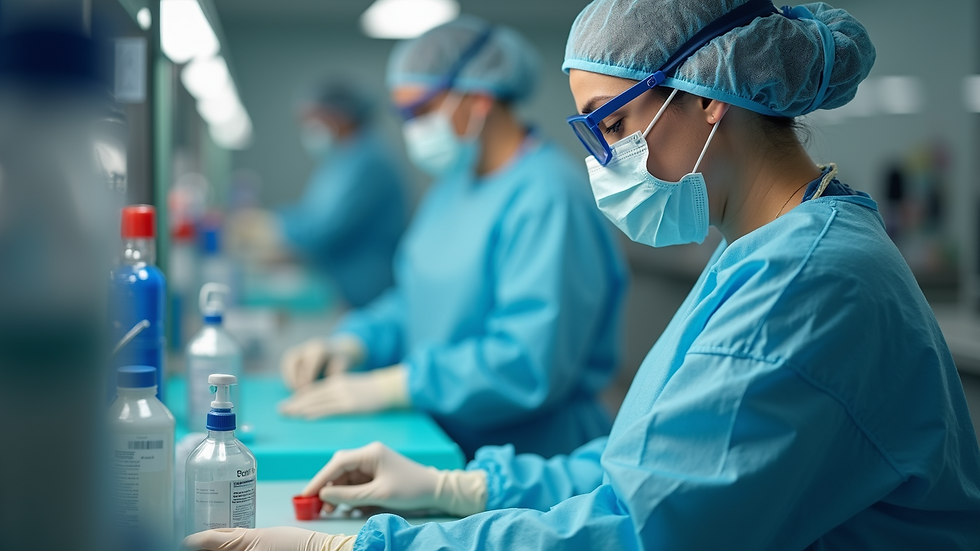Why Do You Need Face Mask & Eye Protection Accessories? Your Guide to Enhanced Safety
- ELITEMEDICAL ACCESSORIESUSA

- Aug 7
- 4 min read
The safety of workers has become a major concern, especially in hazardous industries. To ensure that your workers are protected at all costs, the use of face mask & eye protection accessories has become essential. This protective gear serves as a barrier between you and hazardous substances.

Whether you are working at a clinic, hospital, laboratory, or in the mechanical industry, in every setting, it's important to protect your face and eyes. This blog explores the importance of face and eye protection accessories and how to use them properly.
Types of Injuries You Can Face on Your Face and Eyes
According to a recent study by the American Optometric Association, over 2,000 eye-related injuries occur in workplaces every day in the United States. Safety experts and even doctors believe that protective accessories can prevent 90% of injuries. Here are some common injuries and risks:
1. Chemical Splashes
While working in laboratories, hospitals, or chemical industries, the chances of getting exposed to hazardous chemicals are quite high. Even a single drop of acid can cause irreparable harm.
2. Dust and Particulate Matter
You can often witness construction mines, sites, and woodworking areas filled with airborne dust, metal shavings, and sawdust. It can irritate the eyes, scratch the cornea, or lead to chronic respiratory issues when inhaled.
3. Flying Debris
Welding, grinding, drilling, and machining all produce tiny fragments that can fly into the eyes or face. This could cause cuts, bruising, or even blindness.
4. Biological Hazards
Lab technicians and healthcare professionals work in conditions that put them at risk of exposure to viruses, bodily fluids, and bacteria. A mask helps in shielding you from infections like influenza, dust particles, or bloodborne diseases.
Healthcare professionals and lab technicians are exposed to viruses, bacteria, and bodily fluids. Masks and face shields act as barriers to prevent infections like influenza, COVID-19, or bloodborne diseases.
5. Radiation and UV Exposure
Workers in labs and the welding industry are most prone to ultraviolet or infrared radiation. It can damage the skin and may cause issues like welder's flash or corneal burns.
Benefits of Using Face Mask & Eye Protection Accessories in Hazardous Environments
By investing in the right protective gear, you can enjoy several benefits that go far beyond statutory requirements:
1. Prevents Long-Term Injury
Wearing safety glasses, goggles, or face shields severely reduces the risk of accidents. Proper eye protection can prevent scratches, infections, and even permanent blindness.
2. Improves Respiratory Health
Buy face mask protection, especially N95 or surgical-grade ones, to filter harmful particles like asbestos, smoke, or bacteria. They are crucial in environments where air quality is compromised.
3. Boosts Productivity
By providing face masks & eye protection gear to your workers, you foster trust and reduce downtime from preventable injuries. In fact, it also gives workers more confidence as they feel safe while working.
4. Compliance with Safety Standards
OSHA, CDC, and other safety organisations mandate the use of protective gear in hazardous workplaces. Wearing masks and eye protection ensures compliance and avoids legal consequences.
5. Reduces Disease Transmission
At the time of outbreaks such as COVID-19or seasonal flu, face masks were viewed as the most useful gear in preventing the disease from spreading. Infection rates were significantly reduced at workplaces where face masks were regularly used.
How to Properly Use Face Mask & Eye Protection Accessories
Wearing face masks, eye protection, and PPE is not enough. Only by wearing it correctly and consistently can you enjoy the full benefits of the face mask protection accessories:
1. Choose the Right Equipment for the Job
Use safety goggles for protection against chemical splashes.
Opt for face shields when working with sparks, flying particles, or grinding tools.
Use N95 or respirator masks in contaminated or dusty environments.
Select anti-fog, UV-resistant eyewear for outdoor or welding tasks.
2. Ensure Proper Fit
Make sure that your nose and mouth are properly snug without any gaps.
The eye protection should rest perfectly on the bridge of your nose. If it wraps perfectly around your eyes, dust particles are blocked from all angles.
Your face mask should have adjustable straps and nose clips to ensure a proper fit.
3. Regular Maintenance and Cleaning
Use a gentle cleaner to remove dirt from your safety glasses and face shields.
After use, dispose of your face mask accessories.
Check for any scratches, damage, and cracks regularly.
4. Storage and Handling
Keep your gear clean and dry, away from chemicals or moisture.
Do not touch the inside of your mask or the lens of your googles.
When not in use, keep the glasses in protective cases to avoid scratching or contamination.
5. Training and Education
Employers should provide regular training on how to wear and maintain face and eye protection. Workers should know:
When to replace PPE
How to clean reusable gear
What type of gear should be used for specific tasks
Final Thoughts
It’s no longer an option to wear face mask & eye protection accessories; rather, it has become a necessity in both professional and everyday environments. They not only shield you from chemicals but also prevent you from infectious diseases, thus forming a critical line of defense.
Are you a healthcare provider, scientist, or construction worker? Even if you are just concerned about your own well-being, do make sure to prioritize covering your face and eyes at all costs. As workplace injuries cost billions annually and personal health is becoming more vital than ever, it is better to opt for high-quality PPE and use it correctly.



Comments